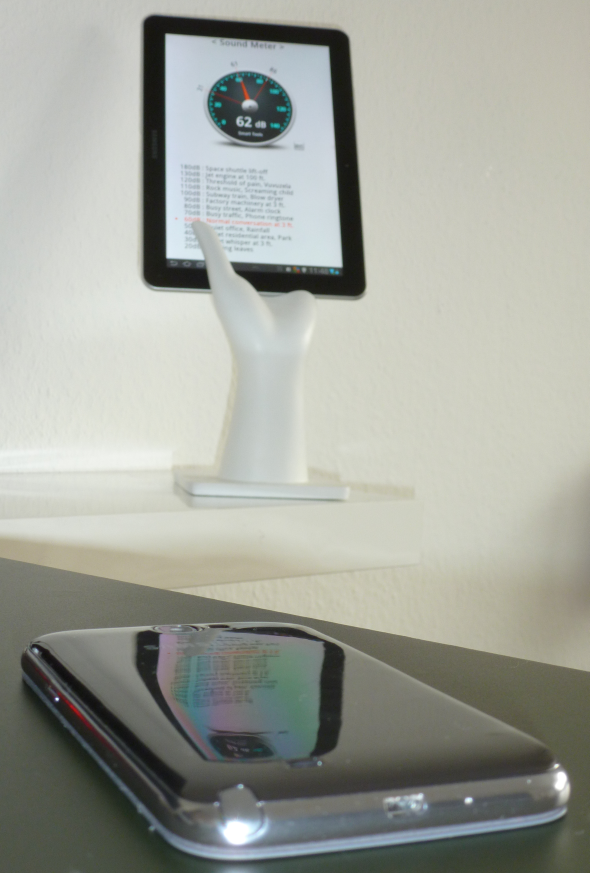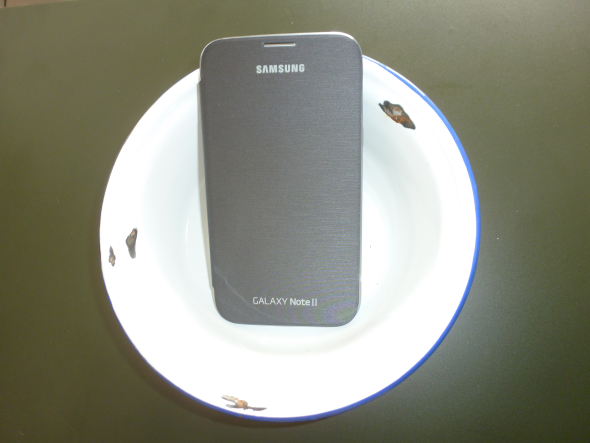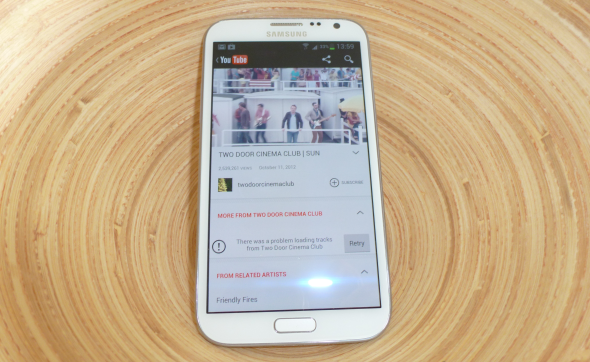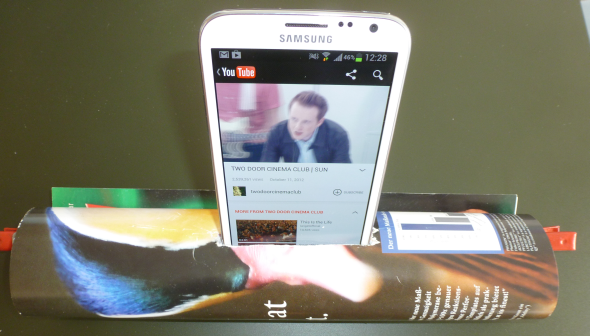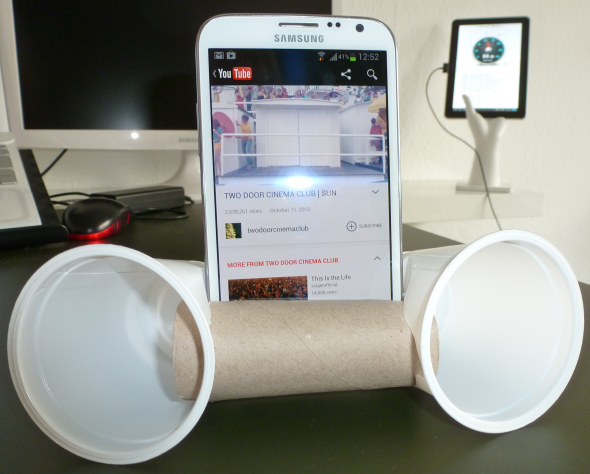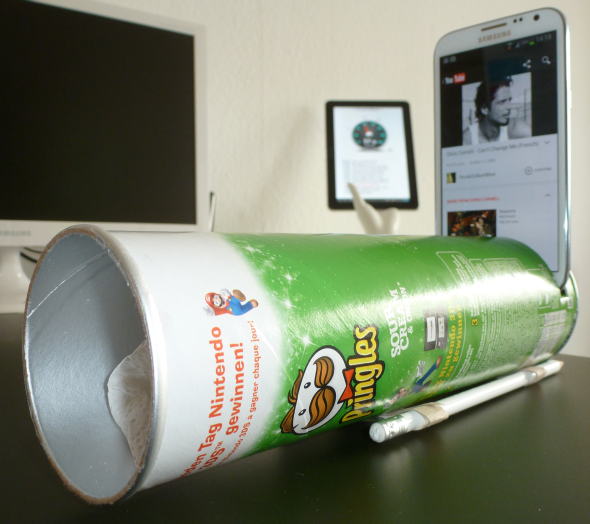The average smartphone speaker is an insult to an audiophile's ears. Poor quality, low volume, and a lack of bass can ruin the sound. Since those speakers are in-built, there isn't an easy way to fix them.
However, before you invest in external speakers, try some quick & easy DIY solutions to significantly improve the sound your mobile produces. These super simple hacks make do with basic household items. Imagine your friends faces when you produce some ace sound with nothing but a salad bowl.
Method
To compare the sound, I first built all DIY speakers I was going to test and marked a spot on the table where I would set them up, with the original speaker being the reference point. The speaker of the Samsung Galaxy Note II sits in the bottom left on the backside of the phone.
I compared sound volume and quality. Quality is described as objectively as possible, but obviously comes down to personal taste. As does the music selection I used.
To gauge the volume, I placed a sound level meter (Android app) at a distance of about 1m and around 30cm above table level. The speaker level of my Samsung Galaxy Note II was set to around 75%. The reference point for measuring the volume is at 2:40 in the song Sun by Two Door Cinema Club. With the phone lying flat on the table and the speaker pointing upwards, the reference volume at this point of the song was 68 dB.
Bowl
The most simple DIY smartphone speaker alternative is a plain bowl. Don't underestimate the size and material of the bowl itself. I tested several different ones, including a bamboo and a plastic salad bowl, as well as smaller ceramic and metal bowls.
The winner in terms of volume was the medium-sized metal bowl, which was 5 dB louder. Note that amplification increases when the phone speaker faces the bottom of the bowl.
The best quality was produced by the larger bamboo bowl. Compared to the plain speaker, the sound was richer and had gained significant depth. It's the best quality sound of all DIY speaker alternatives tested.
Summary
Sound Volume: 73 dB (+5 dB)
Sound Quality: richer and significantly more depth
Alternatives: Other vessels you could try are a large glass or vase or maybe a bucket.
Inspiration: Bowl as iPhone Speaker, Glass as Smartphone Speaker
Rolled Up Magazine
This was the most difficult to produce speaker. I used a cutter knife to carve out the slit for the phone. The result was disappointing, both in terms of volume and quality. The gain was only 3 dB, even when turning the opening towards the sound level meter. The quality is definitely much better than the phone lying flat on the table, but it the music sounded slightly muffled, as if listening to loud music through closed doors.
...
Summary
Sound Volume: 71 dB (+3)
Sound Quality: improved, but slightly muffled
Alternatives: Instead of a magazine, you could also take a toilet paper roll or a plastic pipe.
Inspiration: CocaCola
Toilet Paper Roll & Cups
Similar to the magazine speaker, but slightly enhanced is the toilet paper roll with plastic cups on either side. When placed in the right direction, those were clearly the loudest DIY speakers, even though I used very small and thin cups. I imagine the result will be even more impressive when using larger and more sturdy cups. This will probably also improve the quality. The sound was rather flat, with very little depth.
Sound Volume: 72dB / 76 dB (+4 / +8)
Sound Quality: improved, but very flat
Alternatives: Use a longer paper roll and bigger cups for a better quality sound.
Inspiration: Wildfire Creative DIY Smartphone Speakers
Potato Chips Tube
This is definitely the most ridiculously looking smartphone speaker design. To stabilize the tube, I cut off two rings from a toilet paper roll, taped them to the bottom of the tube, and inserted a pencil on either side. Worked much better for me than taping paper clips to either side.
Despite looking and smelling very unique, this was the best package. It wasn't the loudest speaker or the one with the best quality sound, but it was fairly loud and produced a fairly good sound. And it wasn't just louder, but actually sounded better without stuffing in toilet paper. Although you could argue that the music gains more of a club sound with the extra layers of fabric reflecting the sound.
Sound Volume: 70 / 74 dB (+2 / +6)
Sound Quality: richer, more depth
Alternatives: You can use any other paper roll or pipe, just seal off one end.
Inspiration: Mashable DIY Pringes Speakers
More DIY Speakers
If you search around a little, you will find many more DIY speakers and variations of the above. One of the most simple ones that only requires a toilet paper roll wasn't doable with my huge phone. However, you could just roll a sufficiently large piece of paper or cardboard into a horn shape. Others are designed for the iPhone, like the Whirlwind foldable horn speaker or the iPhone SoundFrame. To create stereo sound, you could channel your headphones into a pair of cups.
Verdict
It doesn't take much to improve the volume and quality of your smartphone speaker sound. However, cheap household items obviously won't be as good as a set of proper speakers. Nevertheless, testing various DIY speakers is a cool project to figure out what sound you like best.
Have you tried any of those DIQ speakers and which one sounded best to you?
Image credits: Sound Speaker via Shutterstock


